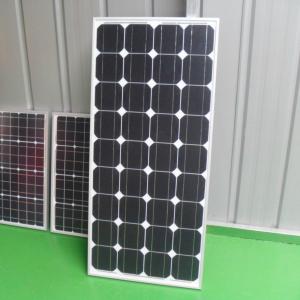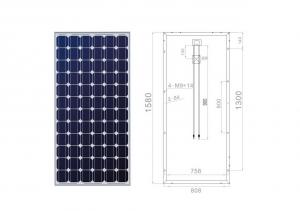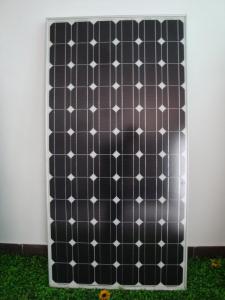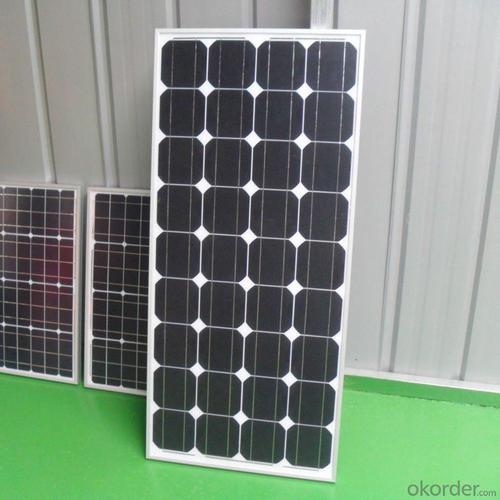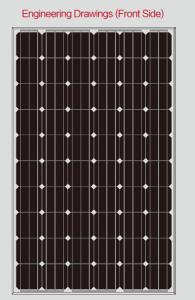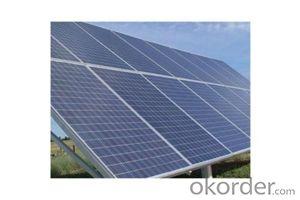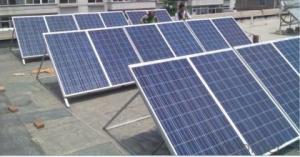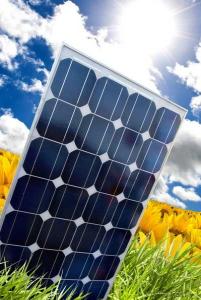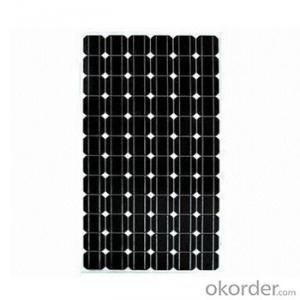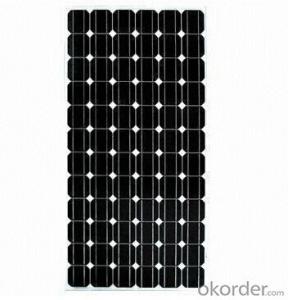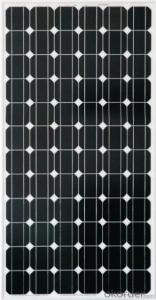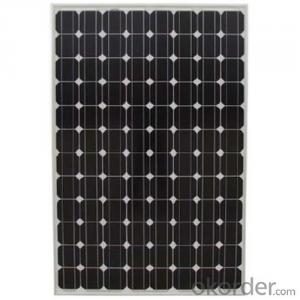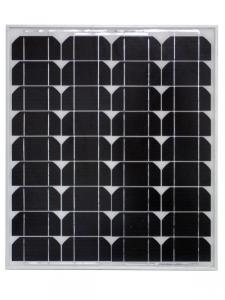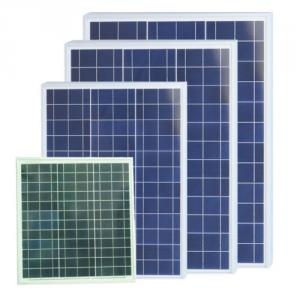Solar Panels for Sheds Kits - Solar Monocrystalline (210W-225W)
- Loading Port:
- Shanghai
- Payment Terms:
- TT
- Min Order Qty:
- 1 pcs pc
- Supply Capability:
- 100000/month pc/month
OKorder Service Pledge
OKorder Financial Service
You Might Also Like
Solar Monocrystalline (210W-225W)
Introduction of Solar Monocrystalline (210W-225W)
Solar modules use light energy (photons) from the sun to generate electricity through the photovoltaic effect. The majority of modules use wafer-based crystalline silicon cells or thin-film cells based on cadmium telluride or silicon. The structural (load carrying) member of a module can either be the top layer or the back layer. Cells must also be protected from mechanical damage and moisture. Most solar modules are rigid, but semi-flexible ones are available, based on thin-film cells. These early solar modules were first used in space in 1958.
CNBM Solar photovoltaic (PV) Panel is designed for large electrical power requirements. It is the optimal choice for both on-grid and off-grid power systems. CNBM Solar panel offers high performance of power per square foot of solar array. Monocrystalline silicon(c-Si): often made using the Czochralski process. Single-crystal wafer cells tend to be expensive, and because they are cut from cylindrical ingots, do not completely cover a square solar cell module without a substantial waste of refined silicon. Hence most c-Si panels have uncovered gaps at the four corners of the cells.
Characteristics of Solar Monocrystalline (210W-225W)
I. Solar Cell : High efficiency crystalline solar cell. Even if under the weak light, the solar module can produce maximum power output.
II. Tempered glass (toughened glass): Anti-reflecting coating and high transmission rate glass increase the power output and mechanical strength of solar module.
III. EVA and TPT: Using high quality EVA and TPT to prevent destroying and water.
IV. AI frame: Without screw, corner connection. 6 holes on the frame can be installed easily.
V. Junction box: Multi function junction box with water proof.
VI. Long lifetime: ≥25 years; Less power decrease.
VII. Good performance of preventing from atrocious weather such as wind and hails.
VIII. Resisting moisture and etching effectively, not effected by geology.
IX. The certificate issued by international authority: UL, TUV, IEC, VDE, CE.
Standard Test Conditions of Solar Monocrystalline (210W-225W)
The opto-electrical specifications shown below are stabilized values being measured at Standard Test Conditions, Irradiance: 1000W/m2, Spectrum: AM1.5 at 25°C, The info below is subject to manufacturing tolerances. Where appropriate minutes of measurement are available and are used for the dimensioning of the installation.
Advantages of Solar Monocrystalline (210W-225W)
• CNBM Solar performance guarantees for 25 years
• 10 years guarantee for workmanship
• Timeliness of delivery
• Quality Products certified (TÜV, UL, CE, VDE, ISO)
CNBM International Corporation's products including Monocrystalline Solar Panel, Polycrystalline Solar Panel have received and enjoyed famous reputation in many countries and regions in the world .As a solar panel manufacturer in China, we strive to provide our customers with excellent service, superior products and unmatched value.
Technical Data of Solar Monocrystalline (210W-225W)
Max Power Voltage Vmp (V) | 27.6V | 27.9V | 28.2V |
Max Power Current Imp (A) | 7.6A | 7.7A | 7.8A |
Open Circuit Voltage Voc (V) | 33V | 33.3V | 33.7V |
Short Circuit Current Isc (A) | 8.48A | 8.61A | 8.71A |
Max Power Pm (W) | 210W | 215W | 220W |
Temperature Coefficient of Cells
NOCT | 47℃±2℃ |
Temperature Coefficients of Isc (%/℃) | 0.0492 |
Temperature Coefficients of Voc (%/℃) | -0.3374 |
Temperature Coefficients of Pmp (%/℃) | -0.4677 |
Mechanical Data of Solar Monocrystalline (210W-225W)
Dimension | 1482×992×40mm |
Weight | 17kg |
Tolerance | 0~+5W |
The dimension of the modules can be changed according to the demand of clients
Limits of Solar Monocrystalline (210W-225W)
Operating Temperature | –40 °C to +85°C |
Storage Temperature | –40 °C to +85°C |
Max System Voltage | 1000VDC(IEC)/600VDC(UL) |
Guarantee of Solar Monocrystalline (210W-225W)
Products Guarantee | 10 yrs free from defects in materials and workmanship |
Performance Guarantee | No less than 90% within 10yrs and no less than 80% within 20yrs |
Certificates | IEC, ISO, TUV, CE |
The Application of Solar Monocrystalline (210W-225W)
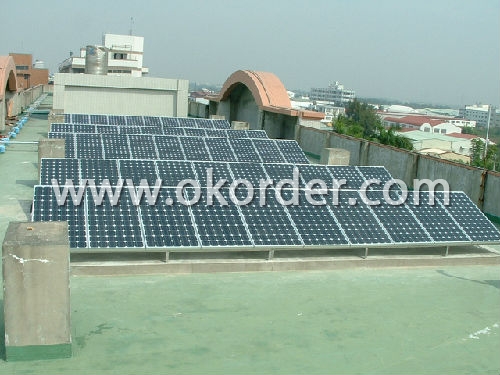
The Pakage of Solar Monocrystalline (210W-225W)
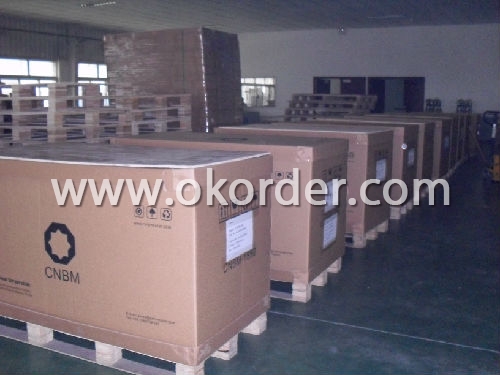
- Q: I read on CNN's website last year some company was creating a very cheap type of solar panel, that needs minimal maintenance and and has minimal glare from the sun. And the creator of the project said he one day wanted to cover every rooftop in the US with these solar panels. Seems like a good idea to me but I havent heared anything of it for a long time and I don't know what they are called... any help?
- The most cost-effective solution, which the vast majority of new installs use today, is solar alongside the regular power company. That way, you need no batteries, and if the solar array isn't producing enough at any given time, you draw from the electric company. When the array is producing more than you need, instead of just throwing that power away, the power company buys it (usually). In short, yes, you will still have an electric bill, but a smaller one. On our house, the electric bill was a little less than $5 a month, with an end-of-year settlement of an additional $2. How much does it cost? Unfortunately, that's like asking how much personal transportation costs. Some people need a van to transport the kids to soccer, some may get by with a motorcycle, others may need only a bicycle. The best thing is to contact a professional installer to get a quote based on your location and electrical usage. Solar electric does not make financial sense in all areas. Our array cost $2,000 but don't use that as a guide. Yours might be 0 times that, or half that, depending on your area and needs.
- Q: i am looking at installing some solar panels and a wind turbine for electricity.has anybody got one of these and how much do they save you?thanks
- Both wind and solar take many years to break even economically, even with government subsidies (Using someones hard-earned tax dollars for your use). If purchased and installed with your own money, they will never pay for themselves because they will need replacement long before you save enough to pay the cost.
- Q: How does the snow cover get removed from the panels?
- Just okorder /... As an aside the efficiency of the panels will also be maintained if the panels are cleaned of dust and debris. The maintenance of removing snow and dust is one argument for having the panels on a rack on the ground. Solar Thermal panels are intended to capture the sun's heat. Two types that make hot water are flat panels and vacuum tube collectors. The vacuum tube collectors work better in colder and cloudy areas but their efficiency prevents heat loss that might melt snow. Most of a light snow will fall between them but you are back to maintenance with a heavier snow. Flat panels are less efficient and will melt a light snow off of the panels for a heavier snow you will need the roof rake. The last type of solar panel are solar air panels. These are most often mounted on the side of a house rather than the roof as they are intended to provide hot air to the living spaces. They are essentially like little greenhouses. Unless the snow is building up against the side of the house these should be free from a snow problem.
- Q: is a wind turbine better than solar panels
- solar water heater and solar power system.
- Q: How can I know the right type of solar panel to choose for my small village house in Africa?
- The power output of a solar panel uses a formula to determine kilowatts produced per hour per square meter per day. This calculation is important because, if you plan to install a solar power system for your home, you will want to know how many solar panels will be needed. To calculate solar power requirements correctly, you need to gather the data that is needed for the calculation. First you have to find the average amount of solar radiation available for your area. You can use a solar radiation chart. This can range from a 4 to a 7 depending on the area you live in. Write the number down on a piece of paper and indicate it with the letters RA. Next is determine the amount of electricity that you use daily. Add the kilowatt-hours used per month from your utility bill. Multiply this number by ,000 to get the watt hours in a month. Divide the total by 30 for the amount of electricity you use daily. Write this number down and indicate it with the letters DE. Determine the percentage of your home that you want to power with the solar power system. Write this number down and indicate it with the letter P. Determine the system inefficiency factor for the solar power system. You should be able to find this on the brochure for the system or from the manufacturer's web site. Write this number down and indicate it by the letter I. Determine the power or yield that is required for your home. Use the equation P = I x (DE x P) / RA to find the power requirements in kWh. Divide the number from Step 5 by the peak wattage for a single solar panel to determine the number of panels you will need for your home. Goodluck! :)
- Q: I found portable solar panels used for boats etc. and was wondering how I could effectly use them for my home instead. If you have used them in the past, please tell how they worked (good or bad).
- well i highly dout that solar panels ued for boats and rvs will work the same for your house, because your house requires more energy to run then a solar power can give.
- Q: Since plants have been populating this earth for the past 475 million years I think they have evolved to gain the most sun with their greenery. If scientists used heat sensors to find the hot spots of trees and trim all of the leaves that don't quot;providefor the plant, then maybe that trimmed tree could be used to become a solar quot;panelquot;. I believe that each individual leaf could be replaced by a small solar panel and the wood of the tree would be wiring that would root all of the solar panels to a generator.
- solar panels do not use generators, but i like your idea, very creative.though i don't see the practicality of this being used commercially, i think it would make a great solar promotional piece though! off-subject, it is time we stop looking at the upfront costs of things and start looking at what the long term costs are. most green-technology, although expensive at first, end up saving tons of resources and actually increase profits of businesses! studies show that people who work in a green building tend to be happier which benefits health, more excited to go to work due to the business's environmental ethics, are more productive because of natural lighting, and are more efficient because more work is getting done. green buildings can actually boost the efficiency of a business! thus saving tons of money and reducing tons of waste. Doesn't this just make sense to you?
- Q: Are the solar panels on the roof just a gimik to get all the tree huggers to buy it, or are they actually a good, efficent design?
- The solar panels run the fan to remove hot air from the car. They do about the same amount of cooling that cracking the windows and using a heatshield over the windshield--that is they keep the interior of the car about the same as the exterior without draining the 2V battery. One problem I have with the solar panels is that they come with a moonroof. The other problem I have with them is that to get them you have to give up the additional safety features because Toyota won't put both the high tech safety features and the solar panels on the same car. So is it a good design? Well, nothing with a sun/moonroof is a good design IMHO, but that's the power of advertising for you. In that it runs a fan without draining the 2V battery, yes that part's good. Having to give up the high tech safety features to get it makes it a non-starter for me (and I live where it gets plenty hot so I could really use the fan).
- Q: Can solar panels be used in areas with high levels of dust?
- Yes, solar panels can still be used in areas with high levels of dust. While excessive dust can reduce the efficiency of solar panels by blocking sunlight, regular cleaning and maintenance can help mitigate this issue. Additionally, advancements in technology, such as self-cleaning panels or coatings that repel dust, are being developed to further enhance the performance of solar panels in dusty environments.
- Q: Are there any government incentives for installing solar panels?
- Yes, there are various government incentives available for installing solar panels. These incentives can include tax credits, grants, and rebates. They aim to promote the use of renewable energy sources and reduce reliance on traditional fossil fuels.
Send your message to us
Solar Panels for Sheds Kits - Solar Monocrystalline (210W-225W)
- Loading Port:
- Shanghai
- Payment Terms:
- TT
- Min Order Qty:
- 1 pcs pc
- Supply Capability:
- 100000/month pc/month
OKorder Service Pledge
OKorder Financial Service
Similar products
Hot products
Hot Searches
Related keywords
